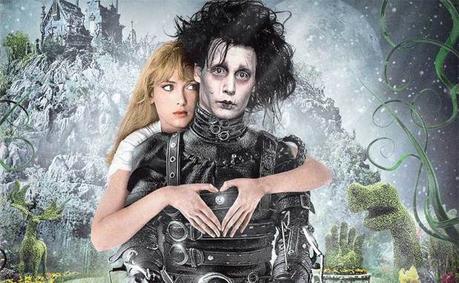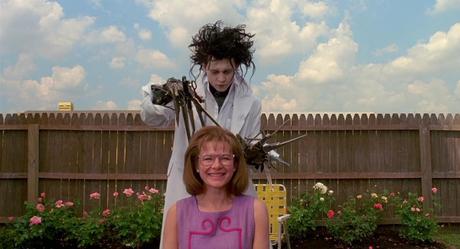 Wynona Ryder embracing Johnny Depp as Edward Scissorhands
Wynona Ryder embracing Johnny Depp as Edward ScissorhandsThis is the movie that firmly cemented heartthrob actor Johnny Depp’s teen-idol “creds,” and with good reason. Sensitive and scarred, the impressionable Edward (charmingly played by Depp) is the scissor-handed Figaro for the laid-back California set — in actuality, the movie was filmed in Central Florida, sort of a return to Johnny and director Tim Burton’s small-town roots. It’s a beautifully crafted, highly sentimental, and mostly enjoyable film, despite brief episodes of crude language and forced humor.
Edward Scissorhands (1990) represents a modern parable of Burton’s pet hang-ups and pent-up feelings of having grown up in middle-class suburbia. It was also his and Depp’s first joint venture, a partnership made in cinematic heaven and one of (at last count) eight feature films they’ve participated in together.
Depp had his best role ever as the misunderstood boy-monster, a walking textbook of physical deformities and psychological debilities, but with a cookie-cutter-shaped heart of gold. In essence, Edward is a Quasimodo for the nineties, an atypical success story driven to fits of anger and violence by the very townspeople he earlier had befriended — fair-weather friends is more like it. Much like Frankenstein’s monster, his story ends in death and tragedy, but Edward lives on, alone but happy in one of those stereotypical old mansions — blissfully trimming the verge as he goes about his business. Parallels to the legend of King Midas and that monarch’s two-sided gift of turning everything he touched into gold are evident throughout.

An allegory of our own equal fascination with and fear of anything different or abnormal, Burton exploits Johnny’s sensitive side to its fullest. Indeed, his angst-derived interpretation of a misfit who just can’t seem to fit in was spot on casting. When the perky Avon lady Peg Boggs (played by a clueless Dianne Wiest) comes a-calling, only to discover Edward hiding under the ruins of what appears to be a window — with one of the window panes shaped like a broken cross — you know you’re in for a makeshift ride through pseudo-religious territory. I’ll be damned if that ruined castle where Edward resides in isn’t a stand-in for a makeshift cathedral.
The young Winona Ryder (whom Depp had been dating during the filming) is equally winning as Edwards’s would-be girlfriend, the blonde cheerleader Kim. Wiest is wonderfully ditzy as the perky, never-say-die Avon lady; a laid-back Alan Arkin is equally fine as Bill, the easygoing head of the household, and an all-but grown-up Anthony Michael Hall is cast (against type) as Jim, Ryder’s spoiled brat of a jock boyfriend. Kathy Baker (The Right Stuff) is a howl as Edward’s sex-starved next-door neighbor Joyce, who just adores Tom Jones, a recurring Burton motif (see Mars Attacks!). And horror-movie icon Vincent Price has a field day as Edward’s elderly inventor, who tries to teach him the finer points of table etiquette, while his half-formed hand twitches nervously nearby.
Composer Danny Elfman’s lovely and evocative score, with celesta and women’s choir in the foreground, is beautifully sung and played by a 79-piece orchestra, a major factor in the movie’s long-term popularity and success. It’s worth comparing to Burton’s next opus, the Henry Selick-directed stop-motion feature The Nightmare Before Christmas, of which it shares a similar production design and art direction. Otherwise, this is early Tim Burton at his emoting best. Just the thing for a romantic Halloween night out for two!
Copyright © 2015 by Josmar F. Lopes

